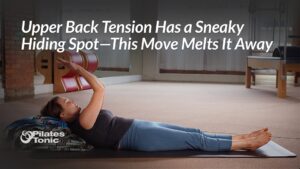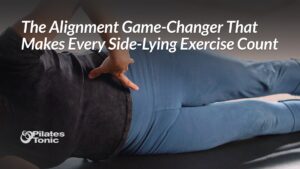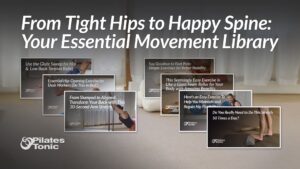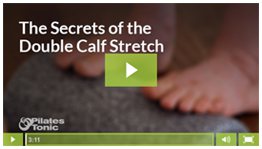Your leg's ability to go behind you is called hip extension. And when it comes to walking, hip extension is vital for a healthy gait.
When the muscles on the front of your hips (your hip flexors and quads) get too tight and short, they can actually prevent your leg from going behind your body. When this happens, it inhibits your glutes from activating and completely changes the way you walk.
If your glutes are unable to activate properly for walking, your body strategizes other ways to keep you moving forward by using your lower back and overworking your hamstrings and calves.
The body’s ability to adapt when certain areas aren’t functioning is pretty amazing and subtle. While this adaptation does keep us upright and moving forward, it also contributes to back pain, knee pain, hip pain and it wears our joints out faster.
Today’s video will help you determine if you're able to extend your leg behind your body, and whether you can do it with ease or not.
If you discover that hip extension is difficult for you, here’re two things you can do right now to help restore your natural hip extension.
Pay Attention To How Much You're Sitting
Chronic sitting sends the message to your body that you don’t need the muscle length in the front of your hips used to extend your leg for walking. Your body adapts by literally shortening the muscles and soft tissue on the front of your hips.
But, as soon as you begin to change the behavior that contributed to the shortening, your body will begin to adapt again.
As you intentionally sit less and/or begin to break up long blocks of sitting on a regular basis, your body will respond to these changes by regenerating the muscle length you lost.
Stretch Your Hip Flexors
While stretching your hip flexors alone isn’t enough to make the changes necessary to regain hip extension, it is a critical component for solving the problem.
For the best results you have to combine the stretches with daily behavior changes designed to change the way you use your body.
Here're a few stretches to add to your daily routine:
- A Subtle Hip Flexor Stretch that Releases Hidden Tightness
- The Easy Standing Hip Flexor Stretch
- A Pain-Relieving, Solo Hip Flexor Stretch You’ll Really Love
If you give the Hip Extension Assessment a try, I’d love to hear how it goes in the comments below!
See you in the studio!
Sydney





4 Responses
Hip flexors! Argh! My problem for sure. My hip bones do not touch the floor. When I do the leg lift test, I can make each hip touch. But, I know that is not good either. Thanks for the stretches. Meeting with Laurel Friday. And, by the way, I like your bangs too! Not clumpy at all!!
Thank you Alison! Hope you enjoy your session with Laurel! 🙂
This is REALLY applicable to my situation with SI pain! I need a couple things clarified though. So, when I’m laying down, my ASIS and pubic bone touch the floor. That’s what you mean by “hip bones” right? And, they do touch the floor, but just laying there, my left is poking into the floor more than my right (consistent with the rotation my pt usually finds). When I try to lift a leg, the side that I’m lifting pushes into the floor a lot and the whole pelvis sorta twists. Nothing comes up completely off the floor, but is it supposed to twist and push like this or is the pelvis supposed to stay in a neutral, even, equally distributed pressure state? Thank you!!
Hi Veronika, These are great questions! I am referring to your ASIS when I say hip bones. Ideally, you’re going for the feeling of even pressure on the front of your hips when you lift your leg from the floor, and hopefully without a lot of effort. That being said, the bones of your pelvic halves do rotate in opposition around your SIJ with every step you take, but it’s a very subtle, almost silent movement. Eric Franklin calls these movements of the bones in the body Bone Rhythms. If you’re feeling a lot of pressure into the floor on the side your lifting, and if you’re having to work to keep the opposite ASIS on the ground, that’s letting you know that your pelvis is probably rotating a little too much when you walk, and taking your lumbar spine with it. The goal is to work toward keeping your pelvis neutral, but not locked down in order for it to be in neutral. This exercise is a great assessment tool to get an idea of where you currently are, and gives you something to refer back to as you make changes. Hope this helps! Thanks for your questions!